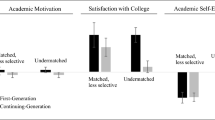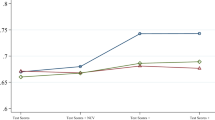Abstract
The attention to students’ noncognitive attributes has recently flourished within academic research and public discourse. This paper adds to the literature by examining the interrelationships among several key noncognitive attributes as well as exploring direct and indirect relationships between noncognitive attributes and second-year retention. Within a multi-institutional sample of 10,622 students, academic self-efficacy, academic grit, self-discipline, and time management all load onto a single noncognitive factor with strong inter-item correlations and internal reliability. Moreover, structural equation modeling analyses indicate a sizable and positive indirect effect of noncognitive attributes on college retention, which is mediated by social adjustment, institutional commitment, and college grade point average.

Similar content being viewed by others
References
Akos, P., & Kretchmar, J. (2017). Investigating grit as a non-cognitive predictor of college success. Review of Higher Education, 40(2), 163–186.
Astin, A. W. (1970). The methodology of research on college impact, part one. Sociology of Education, 43(3), 223–254.
Astin, A. W., & antonio, a. l. (2012). Assessment for excellence: The philosophy and practice of assessment and evaluation in higher education (2nd ed.). New York: Rowman and Littlefield/American Council on Education.
Bandura, A. (1977). Self-efficacy: Toward a unifying theory of behavior change. Psychological Review, 84, 191–215.
Bandura, A. (1986). Social foundations of thought and action: A social cognitive theory. Englewood Cliffs, NJ: Prentice-Hall.
Bean, J., & Eaton, S. (2000). A psychological model of college student retention. In J. M. Braxton (Ed.), Reworking the student departure puzzle (pp. 48–61). Nashville, TN: Vanderbilt University Press.
Berger, J. B., Ramirez, G. B., & Lyons, S. (2012). Past to present: A historical look at retention. In A. Seidman (Ed.), College student retention: Formula for student success (2nd ed., pp. 7–34). Lanham, MD: Rowman and Littlefield.
Bowman, N. A., Hill, P. L., Denson, N., & Bronkema, R. (2015). Keep on truckin’ or stay the course? Exploring grit dimensions as differential predictors of educational achievement, satisfaction, and intentions. Social Psychological and Personality Science, 6, 639–645.
Braxton, J. M. (Ed.). (2000). Reworking the student departure puzzle. Nashville, TN: Vanderbilt University Press.
Bryk, A. S., Gomez, L. M., Grunow, A., & LeMahieu, P. G. (2015). Learning to improve: How America’s schools can get better at getting better. Cambridge, MA: Harvard Education Press.
Cabrera, A. F., Nora, A., & Castañeda, M. B. (1992). The role of finances in the persistence process: A structural model. Research in Higher Education, 33, 571–593.
Caspi, A., Roberts, B. W., & Shiner, R. L. (2005). Personality development: Stability and change. Annual Review of Psychology, 56, 453–484.
Chen, R. (2012). Institutional characteristics and college student dropout risks: A multilevel event history analysis. Research in Higher Education, 53(5), 487–505.
Cohen, J. (1988). Statistical power analysis for the behavioral sciences (2nd ed.). Mahwah, NJ: Lawrence Erlbaum.
Cohen, J., Cohen, P., West, S. G., & Aiken, L. S. (2003). Applied multiple regression/correlation analysis for the behavioral sciences (3rd ed.). Mahwah, NJ: Lawrence Erlbaum.
Connelly, B. S., & Ones, D. S. (2010). An other perspective on personality: Meta-analytic integration of observers’ accuracy and predictive validity. Psychological Bulletin, 136, 1092–1122.
Credé, M., & Niehorster, S. (2012). Adjustment to college as measured by the Student Adaptation to College Questionnaire: A quantitative review of its structure and relationships with correlates and consequences. Educational Psychology Review, 24, 133–165.
Credé, M., Tynan, M. C., & Harms, P. D. (2017). Much ado about grit: A meta-analytic synthesis of the grit literature. Journal of Personality and Social Psychology, 113, 492–511.
Duckworth, A. L., Peterson, C., Matthews, M. D., & Kelly, D. R. (2007). Grit: Perseverance and passion for long-term goals. Journal of Personality and Social Psychology, 92, 1087–1101.
Duckworth, A. L., & Quinn, P. D. (2009). Development and validation of the Short Grit Scale (Grit-S). Journal of Personality Assessment, 91, 166–174.
Duckworth, A. L., & Yeager, D. S. (2015). Measurement matters: Assessing personal qualities other than cognitive ability for educational purposes. Educational Researcher, 44(4), 237–251.
Eskreis-Winkler, L., Shulman, E. P., Beal, S. A., & Duckworth, A. L. (2014). The grit effect: Predicting retention in the military, the workplace, school and marriage. Frontiers in Psychology, 5(36), 1–12.
Farrington, C. A., Roderick, M., Allensworth, E., Nagaoka, J., Keyes, T. S., Johnson, D. W., et al. (2012). Teaching adolescents to become learners. The role of noncognitive factors in shaping school performance: A critical literature review. Chicago: University of Chicago Consortium on Chicago School Research.
Finney, S. J., & DiStefano, C. (2006). Non-normal and categorical data in structural equation modeling. In G. R. Hancock & R. O. Mueller (Eds.), Structural equation modeling: A second course (pp. 269–314). Greenwich, CT: Information Age Publishing.
Furr, R. M., & Bacharach, V. R. (2008). Psychometrics: An introduction. Thousand Oaks, CA: Sage.
Heck, R. H., & Thomas, S. L. (2009). An introduction to multilevel modeling techniques (2nd ed.). New York: Routledge.
Hu, L. T., & Bentler, P. M. (1999). Cutoff criteria for fit indices in covariance structure analysis: Conventional criteria versus new alternatives. Structural Equation Modeling, 6, 1–55.
Hunter, M. S., & Linder, C. W. (2005). First-year seminars. In M. L. Upcraft, J. N. Gardner, & B. O. Barefoot (Eds.), Challenging and supporting the first-year student: A handbook for improving the first year of college (pp. 275–291). San Francisco: Jossey-Bass.
Integrated Postsecondary Education Data System. (2016). IPEDS data center: Custom data files (data file). https://nces.ed.gov/ipeds/datacenter/InstitutionByGroup.aspx.
Ishitani, T. T. (2006). Studying attrition and degree completion behavior among first-generation college students in the United States. Journal of Higher Education, 77(5), 861–885.
Kline, R. B. (2012). Assumptions in structural equation modeling. In R. H. Hoyle (Ed.), Handbook of structural equation modeling (pp. 111–125). New York: Guilford.
Kline, R. B. (2016). Principles and practice of structural equation modeling (4th ed.). New York: Guilford.
Lavaan. (n.d.). Categorical data. http://lavaan.ugent.be/tutorial/cat.html.
Li, D. (2010). They need help: Transfer students from four-year to four-year institutions. Review of Higher Education, 33(2), 207–238.
Long, J. S. (1997). Regression models for categorical and limited dependent variables. Thousand Oaks, CA: Sage.
Mayhew, M. J., Rockenbach, A. N., Bowman, N. A., Seifert, T. A., Wolniak, G. C., Pascarella, E. T., et al. (2016). How college affects students (vol. 3): 21st century evidence that higher education works. San Francisco: Jossey-Bass.
Multon, K. D., Brown, S. D., & Lent, R. W. (1991). Relation of self-efficacy beliefs to academic outcomes: A meta-analytic investigation. Journal of Counseling Psychology, 38, 30–38.
Museus, S. D. (2014). The culturally engaging campus environments (CECE) model: A new theory of college success among racially diverse student populations. In M. B. Paulsen (Ed.), Higher education: Handbook of theory and research (Vol. 29, pp. 189–227). New York, NY: Springer.
Pan, Y.-J. (2010). Modeling the effects of academic and social integration on college student success: A systematic review. Unpublished Doctoral Dissertation, University of Louisville.
Pascarella, E. T., & Terenzini, P. T. (2005). How college affects students: A third decade of research (Vol. 2). San Francisco: Jossey-Bass.
Pedhazur, E. J. (1997). Multiple regression in behavioral research: Explanation and prediction (3rd ed.). New York: Wadsworth.
Poropat, A. E. (2009). A meta-analysis of the Five-Factor Model of personality and academic performance. Psychological Bulletin, 135, 322–338.
Porter, S. R. (2006). What can multilevel models add to institutional research? In M. A. Coughlin (Ed.), Applications of intermediate/advanced statistics in institutional research (resources in institutional research, Vol. 16). Tallahassee, FL: Association for Institutional Research.
Richardson, M., Abraham, C., & Bond, R. (2012). Psychological correlates of university students’ academic performance: A systematic review and meta-analysis. Psychological Bulletin, 138, 353–387.
Robbins, S. B., Lauver, K., Le, H., Davis, D., Langley, R., & Carlstrom, A. (2004). Do psychosocial and study skill factors predict college outcomes? A meta-analysis. Psychological Bulletin, 130, 261–288.
Roberts, B. W., & DelVecchio, W. F. (2000). The rank-order consistency of personality traits from childhood to old age: A quantitative review of longitudinal studies. Psychological Bulletin, 126(1), 3–25.
Roberts, B. W., Lejuez, C., Krueger, R. F., Richards, J. M., & Hill, P. L. (2014). What is conscientiousness and how can it be assessed? Developmental Psychology, 50, 1315–1330.
Robertson-Kraft, C., & Duckworth, A. L. (2014). True grit: Trait-level perseverance and passion for long-term goals predicts effectiveness and retention among novice teachers. Teachers College Record, 116(3), 1–27.
Roksa, J. (2010). Bachelor’s degree completion across state contexts: Does the distribution of enrollments make a difference? Research in Higher Education, 51(1), 1–20.
Rosseel, Y. (2012). Lavaan: An R package for structural equation modeling. Journal of Statistical Software, 48(2), 1–36.
Rowan-Kenyon, H. T., Savitz-Romer, M., Ott, M. W., Swan, A. K., & Liu, P. P. (2017). Finding conceptual coherence: Trends and alignment in the scholarship on noncognitive skills and their role in college success and career readiness. In M. B. Paulsen (Ed.), Higher education: Handbook of theory and research (Vol. 32, pp. 141–179). New York: Springer.
Schuh, J. H., & Gansemer-Topf, A. (2012). Finances and retention: Trends and potential implications. In A. Seidman (Ed.), College student retention: Formula for student success (2nd ed., pp. 101–118). Lanham, MD: Rowman and Littlefield.
Strayhorn, T. L. (2014). What role does grit play in the academic success of Black male collegians at predominantly White institutions? Journal of African American Studies, 18, 1–10.
Tabachnick, B. G., & Fidell, L. S. (2007). Using multivariate statistics (5th ed.). Needham Heights, MA: Allyn and Bacon.
Tinto, V. (1993). Leaving college: Rethinking the causes and cures of student attrition (2nd ed.). Chicago: University of Chicago Press.
Tough, P. (2012). How children succeed: Grit, curiosity, and the hidden power of character. New York: Houghton Mifflin Harcourt.
Walton, G. M. (2014). The new science of wise psychological interventions. Current Directions in Psychological Science, 23(1), 73–82.
Yeager, D. S., Paunesku, D., Walton, G. M., & Dweck, C. S. (2013). How can we instill productive mindsets at scale? A review of the evidence and an initial R&D agenda. In Paper presented at the White House Meeting on Excellence in Education: The importance of academic mindsets, Washington, DC.
Yeager, D. S., & Walton, G. M. (2011). Social–psychological interventions in education: They’re not magic. Review of Educational Research, 81, 267–301.
Author information
Authors and Affiliations
Corresponding author
Rights and permissions
About this article
Cite this article
Bowman, N.A., Miller, A., Woosley, S. et al. Understanding the Link Between Noncognitive Attributes and College Retention. Res High Educ 60, 135–152 (2019). https://doi.org/10.1007/s11162-018-9508-0
Received:
Published:
Issue Date:
DOI: https://doi.org/10.1007/s11162-018-9508-0




